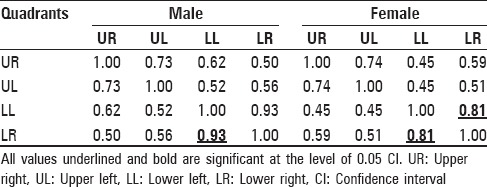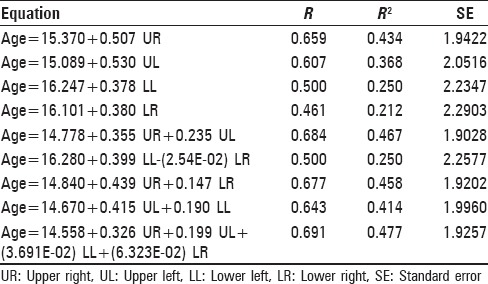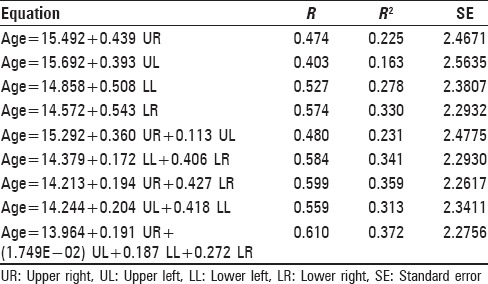Abstract
Aim:
The primary aim of the following study is to estimate the chronological age based on the stages of third molar development following the eight stages (A to H) method of Demirjian et al. (along with two modifications-Orhan) and secondary aim is to compare third molar development with sex and age.
Materials and Methods:
The sample consisted of 115 orthopantomograms from South Indian subjects with known chronological age and gender. Multiple regression analysis was performed with chronological age as the dependable variable and third molar root development as independent variable. All the statistical analysis was performed using the SPSS 11.0 package (IBM ® Corporation).
Results:
Statistically no significant differences were found in third molar development between males and females. Depending on the available number of wisdom teeth in an individual, R2 varied for males from 0.21 to 0.48 and for females from 0.16 to 0.38. New equations were derived for estimating the chronological age.
Conclusion:
The chronological age of a South Indian individual between 14 and 22 years may be estimated based on the regression formulae. However, additional studies with a larger study population must be conducted to meet the need for population-based information on third molar development.
Keywords: Age estimation, Demirjian's method, teeth, third molar
Introduction
Irrefutable identification of individuals is of paramount importance in routine forensic and judicial practice. Age estimation is one of the most important factors employed in establishing the identity of an individual. Teeth are generally preserved for a long time making them reliable entities for age estimation. During periods of tooth development, it is possible to estimate the age by comparison with stage of eruption of deciduous as well as permanent teeth. Age estimation becomes difficult after about 14 years of age, since all permanent teeth except the third molars would have completed their development.[1] For medico-legal purposes, the attainment of 18 years is an important cut-off. The age estimation during this period may be required not only to differentiate the juvenile from adult status but also to estimate age in relation to social benefits, employment and marriage. The wisdom teeth represent the only teeth still in development during this age and are therefore very important for dental age calculation.[2,3,4] This study aims to estimate the chronological age based on the stages of third molar development following the eight stage (A to H) method of Demirjian et al.[5] (along with two modifications by Orhan et al.)[3] and also to compare the variation in third molar development with sex and age.
Materials and Methods
This retrospective study included orthopantomograms of 115 individuals of South Indian Origin with known chronological age and gender from the archives of our dental institution. Of these, 51 were males and 64 females in the age range of 14-22 years. Orthopantomograms showing obvious dental pathology and those in which the third molars could not be visualized clearly were excluded from the study. The age of the patient as well as the gender were obtained from patient record. The number of third molars present in each orthopantomogram was also recorded. Each of the third molars from all quadrants were assessed and categorized into their respective developmental stages using the formation stages described by Demirjian et al. (from stages A to H)[5] with two modifications suggested by Orhan et al.[3] Stage 0 was used in case of absence of and stage 1 indicated the presence of radiolucent bud prior to calcification [Figure 1].
Figure 1.

Stages of third molar mineralization
Multiple linear regression analysis was done using the SPSS 11.0 package.
Results
The third molar formation was examined in 115 individuals of both sexes and the mean ages and standard deviations for the Demirjian stages are described in Table 1. Overall, no significant differences were found in third molar development between males and females (P > 0.05). Significant Pearson correlation coefficients revealed a strong correlation between the different variables [Table 2]. The greatest correlation coefficient was found between the developmental stage of the lower right and lower left third molars, i.e. 0.93 for males and 0.81 for females. The multiple regression analysis delivered several formulae with chronological age as the dependent variable and third molar root development as independent variable. The regression formulae were subdivided based on categories of gender, the number and location of wisdom teeth present. Depending on the available number of wisdom teeth in an individual, R2 varied for males from 0.21 to 0.48 [Table 3]; for females from 0.16 to 0.38 [Table 4]. When all four third molars were present, the standard error for males and females was 1.92 and 2.27 years, respectively [Tables 3 and 4]. Taking into an account, the location and number of fully developed wisdom teeth, the probability for an individual being older than 18 years is expressed [Table 5]. In case of the presence of four fully developed wisdom teeth, this chance was 94.12% for males and 100% for females. A total of two males and three females showed the development of at least one third molar (Stage H) before the age of 18 years [Table 6]. Only one male showed the development of all four third molars with root completion before the age of 18 years [Table 7]. The end of root formation (Stage H) was established in 70.59% of the individuals at the age of 21.
Table 1.
Mean and standard deviation for the mineralization stages in relation to age and sex in the study population

Table 2.
Pearson's correlation coefficient between third molars of all quadrants

Table 3.
Regression equation in males

Table 4.
Regression equation in females

Table 5.
Probability for an individual to be older than 18 years in case of full third molar development

Table 6.
Absolute and total number of individuals <18 years of age showing at least one-third molar with complete root formation

Table 7.
Absolute and total number of individuals <18 years of age showing all four-third-four molars with complete root formation

Discussion
Age estimation continues to remain a challenge to the forensic medicine personnel with the need for accuracy increasing over the past two decades. The Study Group on Forensic Age Diagnostic proposed guidelines for age estimation in the living comprising of a three-step procedure (1) physical examination, (2) bone development and (3) dental development. The physical examination may provide some insight into the individual's age, mainly in subjects younger than 14 years, but not in young adults between 14 and 18 years who have already gone through puberty. Evaluation of bone development, usually done using the left hand wrist radiograph, may not offer accuracy upon completion of skeletal growth and development. The present study uses the third of the afore-mentioned criteria, i.e. dental development (evaluation of the stages of third molar mineralization), to assess the age.[6,7,8]
The single compelling reason to rely on third molar formation (despite its variability in development, eruption pattern, size, contour and relative positions) for estimation of chronologic age is that there are very few, feasible alternative methods during the interval roughly between the mid-teens and early twenties, since by that time all of the other teeth have erupted and completed root formation. This is a crucial period requiring age estimation, particularly in interpretation and judgment of criminal law to differentiate the juvenile from adult status.[2,3,9]
Various classification systems have been devised for evaluating the stages of tooth mineralization (Gleiser and Hunt, 1955; Nolla, 1960; Garn et al., 1962; Haavikko, 1970; Liliequist and Lundberg, 1971; Demirjian et al., 1973; Gustafson and Koch, 1974; Nortje 1983; Harris and Nortje, 1984; Kullman et al., 1992; Kohler et al., 1994) as previously reviewed by Olze et al.[10] Gleiser and Hunt (1955) described the stages of tooth mineralization aided by schematic diagrams and categorized the same into 15 stages.[10] Garn et al. in 1962 analyzed the developmental course of the mandibular third molar by putting forth nine radiographic stages such as small follicle, full follicle, cusp calcification, crown completion, root formation, half root, alveolar eruption, cusp level and apical completion.[11] In the year 1973, Demirjian et al. put forth a hitherto new system of dental age assessment using seven teeth (central incisor through until the second molar) on the left side of the mandible to achieve dental maturity scores. They categorized the tooth development into 8 stages rated on a scale from ‘A’ to ‘H’ with radiographic images and they propounded the exact criteria required for each stage in both uniradicular and multiradicular teeth with the help of schematic diagrams.[5] Gustafson and Koch (1974) clinico-radiographically categorized the status of mineralization as, (1) commencement of mineralization, (2) completion of crown, (3) eruption when the cusp (s) penetrate the gingiva and (4) completion of root (s); Harris and Nortje (1984) gave the 5-stage classification along with diagrammatic representation.[10]
Demirjian's staging chart has been subsequently modified by Solari and Abramovitch[12] and Kasper et al.[13] Demirjian's original method of scoring the calcification stages from A to H was adopted for use on the third molar by Mincer et al. who calculated the likelihood of an individual being at least 18 years of age based on mean age and standard deviation at each grade of calcification.[14]
Of all the afore-mentioned methods, the one that has been extensively used is Demirjian's method which is simple and practical as it clearly defines the stages of tooth development thereby leading to minimal inter and intra-observer variability.[10] Furthermore, it is non-invasive and can be done in-vivo. As the third molar is associated with a high incidence of agenesis, we have included the modifications of Demirjian's method as suggested by Orhan et al., who assigned scores of ‘0’ and ‘1’ in case of absence of third molar and presence of a radiolucent bud respectively.[3]
Olze et al. in their study on mineralization of wisdom teeth in Caucasian, Mongoloid and African population samples found great variability in the attainment of a particular stage of mineralization amongst different populations, which calls for population-specific investigations.[15]
Rai et al. derived statistically significant differences in third molar development stages D and G in males and females in North Indian individuals. Their results indicated that third molar formation was attained earlier in females than in males. However, in the present study no statistically significant difference was seen in the stages of mineralization between males and females.[16]
Demirjian's criteria were utilized by Acharya A.B. to assess the third molar development on orthopantomograms of 221 Indian subjects between the ages of 15-21 years using three different statistical approaches viz. traditional regression analysis, logistic regression analysis and Bayesian prediction. His study surmised that irrespective of the statistical method employed, over one quarter of Indians requiring identification as minor/major were categorized into the wrong age group.[4] However, in view of the great racial and ethnic diversity in India, it would be erroneous to assume homogeneity of the population and our study therefore restricted the sample to individuals of South Indian ancestry. The general equation of regression line is y = a + bx; where y - age, a – constant, b – multiplication factor and x the developmental stage. With this as the base, regression equations have been derived separately for males and females based on the third molars that were present in orthopantomograms of South Indian population. According to our study, if a subject under study presents with a third molar developmental stage anywhere between stages A and D, there is a likelihood that he or she has not attained the age of 18 years. On the other hand, if the root apices are closed, i.e. attainment of stage H, one can be reasonably confident that the subject is indeed at least 18 years of age [Table 1].
Conclusion
From this study of 115 individuals, it can be surmised that in case all four third molars are present:
The chronological age of a South Indian individual may be estimated based on regression formulae with a standard error of 1.92 and 2.27 years in males and females respectively
The probability of a South Indian individual being older than 18 years is 94.12% and 100% for males and females respectively when all the third molars have attained the stage H.
The data described above may provide a reference for the forensic application of the third molar examinations to the South Indian population. Additional studies with a larger study population must be conducted to meet the need for population-based information on third molar development.
However, it is important to remember that age estimation concerns biology and variation is to be expected. One must be cautious in interpretation and application of results so obtained as the methods used help to determine an individual's overall maturity and may only approximate the chronological age. This further stresses the need for multifactorial methods of age estimation (physical examination, bone and dental development) which when used according to their reliability may help to control the variation that occurs with age when a single indicator is used.[6,17]
Footnotes
Source of Support: Nil
Conflict of Interest: None declared
References
- 1.Bhat VJ, Kamath GP. Age estimation from root development of mandibular third molars in comparison with skeletal age of wrist joint. Am J Forensic Med Pathol. 2007;28:238–41. doi: 10.1097/PAF.0b013e31805f67c0. [DOI] [PubMed] [Google Scholar]
- 2.Sisman Y, Uysal T, Yagmur F, Ramoglu SI. Third-molar development in relation to chronologic age in Turkish children and young adults. Angle Orthod. 2007;77:1040–5. doi: 10.2319/101906-430.1. [DOI] [PubMed] [Google Scholar]
- 3.Orhan K, Ozer L, Orhan AI, Dogan S, Paksoy CS. Radiographic evaluation of third molar development in relation to chronological age among Turkish children and youth. Forensic Sci Int. 2007;165:46–51. doi: 10.1016/j.forsciint.2006.02.046. [DOI] [PubMed] [Google Scholar]
- 4.Acharya AB. Accuracy of predicting 18 years of age from mandibular third molar development in an Indian sample using Demirjian's ten-stage criteria. Int J Legal Med. 2011;125:227–33. doi: 10.1007/s00414-010-0522-9. [DOI] [PubMed] [Google Scholar]
- 5.Demirjian A, Goldstein H, Tanner JM. A new system of dental age assessment. Hum Biol. 1973;45:211–27. [PubMed] [Google Scholar]
- 6.Cunha E, Baccino E, Martrille L, Ramsthaler F, Prieto J, Schuliar Y, et al. The problem of aging human remains and living individuals: A review. Forensic Sci Int. 2009;193:1–13. doi: 10.1016/j.forsciint.2009.09.008. [DOI] [PubMed] [Google Scholar]
- 7.Santoro V, De Donno A, Marrone M, Campobasso CP, Introna F. Forensic age estimation of living individuals: A retrospective analysis. Forensic Sci Int. 2009;193:129.e1–4. doi: 10.1016/j.forsciint.2009.09.014. [DOI] [PubMed] [Google Scholar]
- 8.Kullman L. Accuracy of two dental and one skeletal age estimation method in Swedish adolescents. Forensic Sci Int. 1995;75:225–36. doi: 10.1016/0379-0738(95)01792-5. [DOI] [PubMed] [Google Scholar]
- 9.Panchbhai AS. Radiographic evaluation of developmental stages of third molar in relation to chronological age as applicability in forensic age estimation. Dentistry. 2012;S1 002:2161–1122. [Google Scholar]
- 10.Olze A, Bilang D, Schmidt S, Wernecke KD, Geserick G, Schmeling A. Validation of common classification systems for assessing the mineralization of third molars. Int J Legal Med. 2005;119:22–6. doi: 10.1007/s00414-004-0489-5. [DOI] [PubMed] [Google Scholar]
- 11.Garn SM, Lewis B, Bonne B. Third molar formation and its development course. Angle Orthodo. 1962;32:270–9. [Google Scholar]
- 12.Solari AC, Abramovitch K. The accuracy and precision of third molar development as an indicator of chronological age in Hispanics. J Forensic Sci. 2002;47:531–5. [PubMed] [Google Scholar]
- 13.Kasper KA, Austin D, Kvanli AH, Rios TR, Senn DR. Reliability of third molar development for age estimation in a Texas Hispanic population: A comparison study. J Forensic Sci. 2009;54:651–7. doi: 10.1111/j.1556-4029.2009.01031.x. [DOI] [PubMed] [Google Scholar]
- 14.Mincer HH, Harris EF, Berryman HE. The A.B.F.O. study of third molar development and its use as an estimator of chronological age. J Forensic Sci. 1993;38:379–90. [PubMed] [Google Scholar]
- 15.Olze A, Schmeling A, Taniguchi M, Maeda H, van Niekerk P, Wernecke KD, et al. Forensic age estimation in living subjects: The ethnic factor in wisdom tooth mineralization. Int J Legal Med. 2004;118:170–3. doi: 10.1007/s00414-004-0434-7. [DOI] [PubMed] [Google Scholar]
- 16.Rai B, Kaur J, Anand SC. Mandibular third molar development staging to chronologic age and sex in north Indian children and young adults. J Forensic Odontostomatol. 2009;27:45–9. [PubMed] [Google Scholar]
- 17.Bedford ME, Russell KF, Lovejoy CO, Meindl RS, Simpson SW, Stuart-Macadam PL. Test of the multifactorial aging method using skeletons with known ages-at-death from the Grant Collection. Am J Phys Anthropol. 1993;91:287–97. doi: 10.1002/ajpa.1330910304. [DOI] [PubMed] [Google Scholar]


